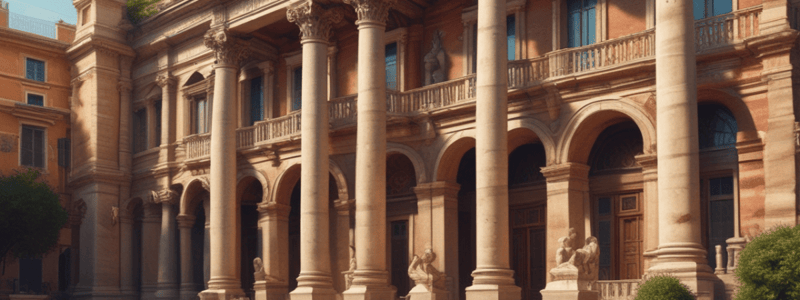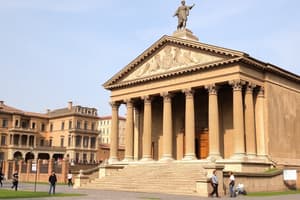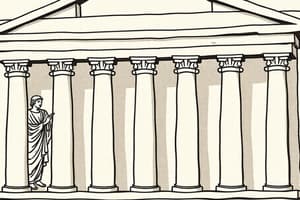Podcast
Questions and Answers
What was the cornerstone of Roman law?
What was the cornerstone of Roman law?
- The Corpus Juris Civilis
- The Lex Romana
- The Twelve Tables (correct)
- The Justinian Code
Which languages evolved from Latin, the language spoken by the Romans?
Which languages evolved from Latin, the language spoken by the Romans?
- Romance languages (correct)
- Celtic languages
- Slavic languages
- Germanic languages
Which architectural achievement demonstrates the Romans' ingenious use of concrete and arches?
Which architectural achievement demonstrates the Romans' ingenious use of concrete and arches?
- The Eiffel Tower
- The Great Pyramid of Giza
- The Taj Mahal
- The Colosseum (correct)
What was the lingua franca of the Roman Empire, facilitating communication among citizens from diverse regions?
What was the lingua franca of the Roman Empire, facilitating communication among citizens from diverse regions?
Which legal code consolidated Roman law during the reign of Justinian I in the 6th century CE, making it easier to navigate and enforce?
Which legal code consolidated Roman law during the reign of Justinian I in the 6th century CE, making it easier to navigate and enforce?
Which architectural element did the Romans pioneer, transforming construction techniques and enabling the erection of monumental edifices?
Which architectural element did the Romans pioneer, transforming construction techniques and enabling the erection of monumental edifices?
Which of the following is NOT one of the Romance languages that evolved from Latin?
Which of the following is NOT one of the Romance languages that evolved from Latin?
Which of the following architectural structures was NOT built by the Romans?
Which of the following architectural structures was NOT built by the Romans?
What was the primary purpose of the Twelve Tables in Roman law?
What was the primary purpose of the Twelve Tables in Roman law?
Which of the following Roman arches was built to commemorate a victory over Maxentius?
Which of the following Roman arches was built to commemorate a victory over Maxentius?
What is the approximate height of the Arch of Constantine, the largest surviving triple arch?
What is the approximate height of the Arch of Constantine, the largest surviving triple arch?
Which of the following is NOT a notable example of a Roman aqueduct mentioned in the text?
Which of the following is NOT a notable example of a Roman aqueduct mentioned in the text?
What is the most striking feature of the Pantheon, the famous Roman temple?
What is the most striking feature of the Pantheon, the famous Roman temple?
What was the primary function of the Roman forums?
What was the primary function of the Roman forums?
Which famous Roman architect worked on the Forum of Trajan?
Which famous Roman architect worked on the Forum of Trajan?
What was the purpose of the five niches in the interior of the Pantheon?
What was the purpose of the five niches in the interior of the Pantheon?
What was the primary purpose of the Roman basilicas located within the forums?
What was the primary purpose of the Roman basilicas located within the forums?
What was the primary purpose of the Colosseum?
What was the primary purpose of the Colosseum?
Which of the following best describes the interior structure of the Colosseum?
Which of the following best describes the interior structure of the Colosseum?
What were the rooms underneath the arena floor of the Colosseum used for?
What were the rooms underneath the arena floor of the Colosseum used for?
What was the primary purpose of Roman arches?
What was the primary purpose of Roman arches?
Which of the following materials was commonly used in the construction of Roman arches?
Which of the following materials was commonly used in the construction of Roman arches?
Which of the following structures is NOT a famous example of Roman architecture?
Which of the following structures is NOT a famous example of Roman architecture?
What was the primary function of the Roman Forum?
What was the primary function of the Roman Forum?
Flashcards are hidden until you start studying
Study Notes
Ancient Rome
Roman Law
Ancient Rome's legal system was highly influential, leading to the development of many modern legal concepts. The Twelve Tables, established around 450 BCE, formed the cornerstone of Roman law. These tables outlined laws concerning personal injury, property disputes, wills, inheritances, and marriage. Later, during the reign of Justinian I in the 6th century CE, the Corpus Juris Civilis consolidated Roman law, making it easier to navigate and enforce. Awareness and study of Roman law persisted throughout Europe’s Middle Ages, shaping various legal systems, including those in England and the United States.
Romance Languages
Roman law also influenced language development. Latin, the language spoken by the Romans, evolved into the Romance languages: Italian, French, Spanish, Portuguese, and Romanian. These languages share a common ancestry and showcase similar grammatical structures, syntax, and vocabulary.
Roman Architecture
Ancient Rome's architectural achievements continue to inspire and influence contemporary design. Structures such as the Colosseum, Pantheon, and Trajan's Market demonstrate the Romans' ingenious use of concrete and arches. They pioneered the arch, vault, and dome, transforming construction techniques and enabling the erection of monumental edifices.
Latin
Latin was the lingua franca of the Roman Empire, facilitating communication among citizens from diverse regions. It became the basis for the Romance languages mentioned earlier and played a crucial role in diplomacy, trade, and cultural exchange.
Roman Roads
One of the most enduring symbols of ancient Rome is its network of roads. Their engineering skills allowed them to construct straight, well-maintained roads that extended across the empire. These roads enabled efficient transportation of goods, troops, and information. Many of these ancient Roman roads can still be seen today and serve as reminders of the empire's grandeur.
Studying That Suits You
Use AI to generate personalized quizzes and flashcards to suit your learning preferences.




